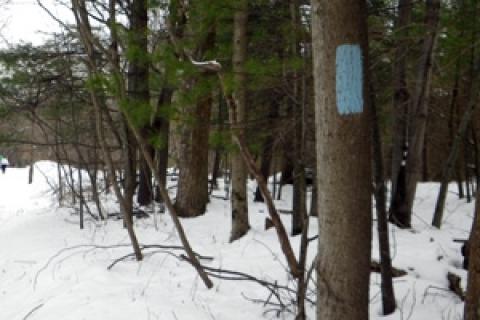
T he trail was covered with a couple inches of snow — obviously not winter tundra conditions — but the trail conditions required hikers' attention. I was within ear shot of the trailhead parking lot. A group of voices floating from the parking lot and out into the forest told me a family hike was about to begin. I was correct — a middle-aged couple and two offspring (the kids were already engaged in a brief snowball fight). We traded greetings and I took it upon myself to warn them of the creek crossing less than a half-mile ahead. No bridge was present, that they knew, but the frozen creek banks seemed to surprise them. They thanked me for the report and I wished them a safe adventure and off we went.
he trail was covered with a couple inches of snow — obviously not winter tundra conditions — but the trail conditions required hikers' attention. I was within ear shot of the trailhead parking lot. A group of voices floating from the parking lot and out into the forest told me a family hike was about to begin. I was correct — a middle-aged couple and two offspring (the kids were already engaged in a brief snowball fight). We traded greetings and I took it upon myself to warn them of the creek crossing less than a half-mile ahead. No bridge was present, that they knew, but the frozen creek banks seemed to surprise them. They thanked me for the report and I wished them a safe adventure and off we went.
As the family started down the trail, I noticed the kiddos were wearing tennis shoes, which they improvised as skates, skidding down the trail. Their parents were only wearing sneakers as well. I bet I looked like an overdressed hiking nerd to this family: ankle supporting boots (waterproof and insulated), trekking poles, day pack (with a spare bottle of water and First-aid kit), and strap-on ice cleats for the boots. The cleats worked nicely crossing that creek and its banks.
Too many cold-weather hiking accidents happen because of neglecting to prepare with the proper gear, or by simply remaining in the autumn-season mode and thinking, "Ah, it's only the first snow of the year and it's not that cold". It's better to be over geared than under geared. Follow a few guidelines on the hiking trail as Christmas nears.
Before leaving the house, check for a trail report issued by the park service or land management officers. Also, check the local hiking message boards on the Internet. Sometimes, the up-to-date info is found there. At the trailhead, keep an eye out for posted signs warning of slippery slopes, downed trees or other trail obstacles. Be sure a trail map is included in the daypack, as snow or leaf-covered trails can seem to disappear. Back the map up with a GPS and/or compass — even on easy trails. An extra bottle of drinking water, sturdy boots and ice cleats and trekking poles were already mentioned.
Don't take for granted, the trail conditions and your physical conditions. The colder air will zap your ability to maintain the mileage you handled only a month ago. Cold-season hiking is a great way to keep in shape through the winter, but it also brings a specific set of dangers. Use common sense and the proper gear and the hiking season will trek on.
- 2812 views

